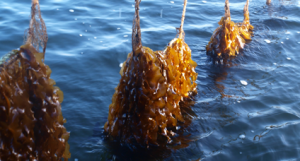The MAB3 project

Færker Vig
Macroalgae have, more than any land-based crop, the ability to produce natural biomolecules suitable for an array of different applications. Such biomolecules can be extracted for added value in cosmetics, pharmaceuticals, hydrocolloids, food applications, textiles, chemicals, marine protein, and food and feed ingredients. Currently, the European seaweed industry relies on seaweeds collected from the wild, with the exception of some Asian and African seaweed, such as Kappaphycus and Eucheuma, which are cultivated for carrageenan extraction. The Danish MAB3 project (www.mab3.dk) goes beyond state-of-the-art by exploring seaweed cultivation in Denmark and the Faroe Islands for future energy carriers like ethanol, butanol and biogas in co-production with protein, amino acids and other value-added products.
Cultivation of the two brown algae Laminaria digitata and Saccharina latissima has been successfully implemented in the MAB3 project by adapting mussel long-line cultivation and harvest technology. Due to seasonal variation of naturally developed carbohydrates, seaweeds need to be harvested in late summer for energy production (i.e. ethanol, butanol and biogas). However, biofouling, caused by contamination with mussels, snails, and other marine organisms, is a serious problem in the low water and low salinity areas, which can lead to total loss of sugar-rich seaweed biomass during the summer period. Offshore sites in Denmark have now been identified for safe seaweed cultivation and supply, e.g. nearby Hanstholm, where a natural population of L. digitata was harvested in August with contents of up to 56% glycan. In the Faroe Islands, cultivation of Saccharina latissima has been proven for more the three years, and with substantial biomass yields year around.
Our project results have proven that a combined ethanol production and subsequent protein enrichment in the solid residue was achieved by simple yeast fermentation of L. digitata without any pretreatment applied. Nearly 80% conversion to ethanol of the fermentable sugars was obtained, together with an enriched protein residue which can serve as an ingredient in fish feed. The biogas yield for this sugar-rich L. digitata was in the range of 450mL CH4/g VS; however, seaweed from early harvest inhibited the biogas process, due to high contents of antioxidants that should be extracted together with other high value-added components prior to the energy production.
Growing seaweed is the most effective way to assimilate CO2 from the biosphere and thus benefit the climate. The results found in the MAB3 project indicate that the assimilation of (assumed) fossil emissions (in terms of CO2 and N2O), measured in CO2 equivalents, is higher than the total emissions from the whole macroalgae production and biorefinery system.
MAB3 calculations show that a macroalgae cultivation system delivers climate mitigation services in the range of 1.4 to 2kg CO2 eq./kg seaweed dry weight. The value of the climate mitigation using the CO2 quota approach €34/tonnes macroalgae dry weight. Thus, seaweed cultivation is an effective way to absorb CO2 and excess nutrients from the biosphere, and at the same time provide our society with a new biomass feedstock with natural bioactive molecules, protein and sugars for future energy supply.
Professor Anne-Belinda Bjerre
Co-ordinator
Danish Technological Institute (DTI),
Gregersvej 1, 2630 Tåstrup,
Denmark
mob: +45 72 20 29 12
www.dti.dk/


